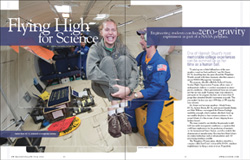Flying High for Science
Engineering students conduct zero-gravityexperiment as part of a NASA program.
One of Hannah Stuart's most memorable college experiences can be summed up as her time as a human ball.
"I curled up into a little ball and two of the crew-members tossed me back and forth," says Ms. Stuart, BS '11, describing time she spent aboard the Weightless Wonder aircraft with three classmates after they earned a spot in NASA's Microgravity University.
The program, officially called the Reduced Gravity Student Flight Opportunities Program, allows teams of undergraduate students to conduct experiments in micro-gravity conditions—where gravitational forces are not quite zero but are very small. Fourteen teams were selected to participate in the program this June out of more than 60 groups that submitted detailed experiment proposals. This year marked the first year since 1999 that a GW team has been selected.
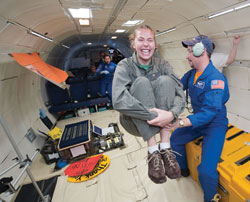
Hannah Stuart, BS '11, somersaults in microgravity conditions.
All photos, courtesy of NASA
Ms. Stuart and her team members—Micah Foster, BS '11, Andrew Breest, BS '11, and seniors Danielle Barsky and Matt Wilkins—investigated the Plateau-Rayleigh instability principle, which explains why fluids break up into smaller droplets as their streams accelerate to the ground (think of a thin stream of water dripping from a kitchen faucet).
The team wanted to see whether the principle would hold true under microgravity conditions—a question that could have implications for the production of materials on the International Space Station, as well as in fields like pharmaceutical manufacturing. Knowing how fluids behave also makes technology such as ink-jet printers and 3-D prototyping machines possible.
The Weightless Wonder plane, which is owned by a company called ZeroG and contracted by NASA, simulates weightlessness by flying a series of about 30 parabolic curves over the Gulf of Mexico. Near the crest of each parabola, fliers in the plane experience about 25 seconds of weightlessness. During the 100-minute flight, which includes takeoff and landing, fliers can expect about 13 total minutes of weightlessness. At this time, teams are expected to run their experiments and gather as much data as possible.
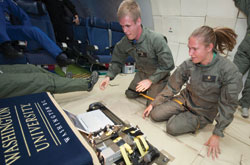
Andrew Breest, BS '11, and Hannah Stuart, BS '11, conduct their experiment aboard the Weightless Wonder plane.
For the team, preparation for 13 minutes of experimentation started months before. The students learned that their proposal had been accepted in December 2010, which kick-started a six-month period of building and testing their experiment apparatus, as well as conducting outreach activities with science students at local schools.
"The students practiced doing the experiment over and over. Their skill in conducting the experiment would be the most important thing," says Charles Garris, a mechanical and aerospace engineering professor who helped mentor the team. The testing apparatus included a syringe pump that the students used to create a steady stream of fluid, kept at a constant velocity. A camera system captured images of the fluid as it was released from the syringe and as droplets formed.
Getting ready for takeoff also included 10 days in Houston at NASA's Johnson Space Center, where the team underwent rigorous equipment testing and participated in training sessions and anti-motion-sickness briefings.
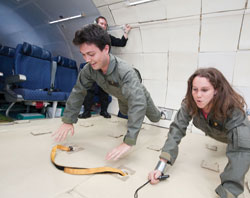
Micah Foster's, BS '11, and senior Danielle Barsky's bodies lift from the ground in an area near where their microgravity experiment.
"The first time in zero G, you feel like the plane is dropping out from under you, and you want to grab onto something. That makes it worse," Mr. Foster says. "It's best if you can relax."
They also learned, in physiology briefings, tricks to minimize motion sickness while in zero gravity, including keeping their heads still as if wearing neck braces, not looking out the windows, and singing to distract themselves. No one on the GW team got sick, but about eight students from other participating schools weren't so lucky.
Between each microgravity cycle, the students experienced 2 Gs—double the gravitational pull that we feel on Earth. During these times, even lifting an arm was difficult. The team divided in half and participated in two separate flights to provide more opportunities for data collection. (Mr. Wilkins was unable to attend Flight Week in Houston because of illness.)
But when the data collection was complete, each team member still had some parabolas left over for fun before the flight ended. In addition to floating around the plane, they played with a Slinky in zero gravity and tried the "human ball" trick.
Ms. Stuart says the group had support from mentors across the School of Engineering and Applied Science including Dr. Garris, Dean David Dolling, and William Rutkowski, a GW employee in the machine shop who helped the students fabricate their experimental apparatus. "The whole support system here was phenomenal," she says, "from the administrators and the staff to the machine shop guys. We have so much gratitude toward our mentors in this project."
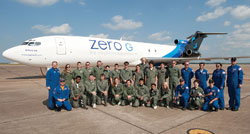
Students who participated in NASA's Microgravity University traveled on a plane that simulates weightlessness by flying a series of about 30 parabolic curves over the Gulf of Mexico.
During the summer, the team worked with Dr. Garris to analyze the data they collected during their flights, which they hope to publish in a peer-reviewed journal. This fall, the four team members are continuing on career and educational paths that will benefit from their microgravity experience: Mr. Breest entered flight school as a second lieutenant in the Air Force; Ms. Stuart has started graduate school at Stanford University studying sustainable energy system design; Mr. Foster is attending graduate school at Cornell University studying aerospace engineering; and Ms. Barsky has returned for her senior year at GW, after which she's considering entering the workforce as a mechanical engineer.
"This project was quite an unbelievable send-off from GW," Mr. Breest says. "It's truly a once-in-a-lifetime opportunity."

